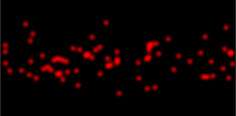Scientists Discover How Cells Build a 'Machine' for Cell Division

Using time-lapse photography and computer modeling, a team of researchers from Columbia, Yale and Lehigh Universities has explained a mystery surrounding the assembly of a cellular structure responsible for cell division, the vital process which enables living creatures to develop from embryo to adult.
Termed the ‘contractile ring,’ the structure is a tiny muscle-like ring used by cells to literally pinch themselves into two genetically identical daughter cells at the end of mitosis, the stage where the nucleus divides into two. Scientists believe the contractile ring acts like an old-fashioned purse string that eventually draws together before severing one cell into two.
Understanding contractile ring assembly may also have important implications on human health. Recent studies suggest that failure of the cell-separating machinery may be associated with tumor development in cancer.
“Scientists have known for decades that the ring, like a muscle, consists of proteins capable of exerting force,” said Thomas Pollard, chair of the Department of Molecular, Cellular and Developmental Biology at Yale, “but we did not have a plausible mechanism to explain how a cell puts together this short-lived, force-producing structure, which is always located precisely between the two daughter nuclei. We found that yeast cells assemble their contractile ring using a search, capture, pull and release mechanism.”
Ben O’Shaughnessy, professor of chemical engineering at Columbia University, led a group that developed computer simulations quantitatively analyzing this mechanism.
“Our work shows how a cell executes the challenging task of assembling the working parts of its contractile machinery in just the right way,” said O’Shaughnessy. “The team of biologists and physicists integrated live cell observations, data analysis and computer simulations to reveal a remarkable assembly mechanism. The collaboration demonstrated the crucial role of perspectives and techniques from the physical sciences and engineering in the new biology.”
Using yeast cells, the researchers discovered that cells undergoing mitosis generate protein clusters (nodes) on the inside of the cell membrane around the cell’s equator. These nodes produce filaments growing in random directions. When a filament encounters and pairs with another node, it begins pulling the two nodes together. Connections are broken after about 20 seconds, only to be replaced by new connections between other pairs of nodes.
O’Shaughnessy explains that while seemingly counterproductive, the breaks and reconnections in this ‘search and capture’ strategy seem crucial for the ring assembly process. “The ring assembly consists of many episodes of attraction between node pairs,” O’Shaughnessy said. “These proceed in parallel and eventually position the nodes into a nicely condensed contractile ring around the equator, ready to pinch the mother into two daughters at a later stage.”
The assembly process found in yeast may hold important clues for human cells. “Future work will involve testing the concepts learned from yeast in other cell types to learn if the mechanism is universal,” said Pollard. “Since other cells, including human cells, depend on similar proteins for cytokinesis (cell division into two daughter cells), it is entirely possible that they use the same strategy.”
The research was conducted by cell biologists at Yale and physicists at Columbia and Lehigh. Dimitris Vavylonis, assistant professor of physics at Lehigh, (formerly at Columbia and Yale), said, “A key aspect of this research project was the use of computer modeling simulations at every step of the process to test what was feasible physically and to help guide the experiments.”
Jian-Qiu Wu was part of the cell biology effort at Yale and is now assistant professor of molecular genetics and cellular biochemistry at Ohio State. “The essence of the approach was that experiment and modeling proceeded hand-in-hand,” Wu said. “Our simulations neatly paralleled actual research outcomes.”
Watch a series of videos published in the current issue of Science that illustrate the discoveries about cell division -- www.sciencemag.org/cgi/content/full/1151086/DC1
Source: by David Poratta, Columbia University



















